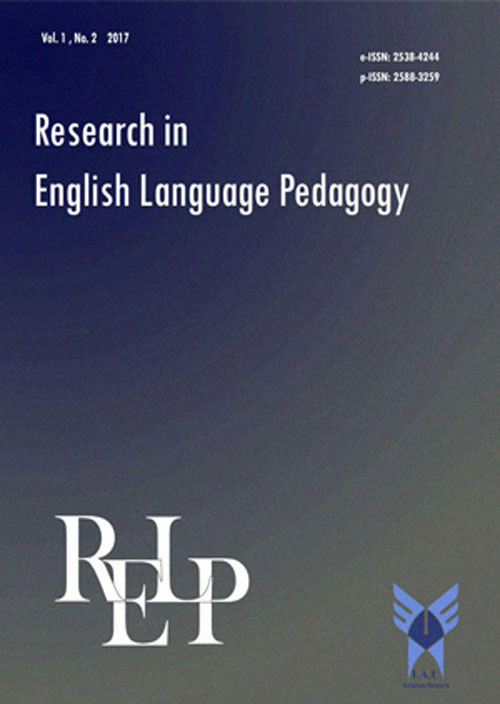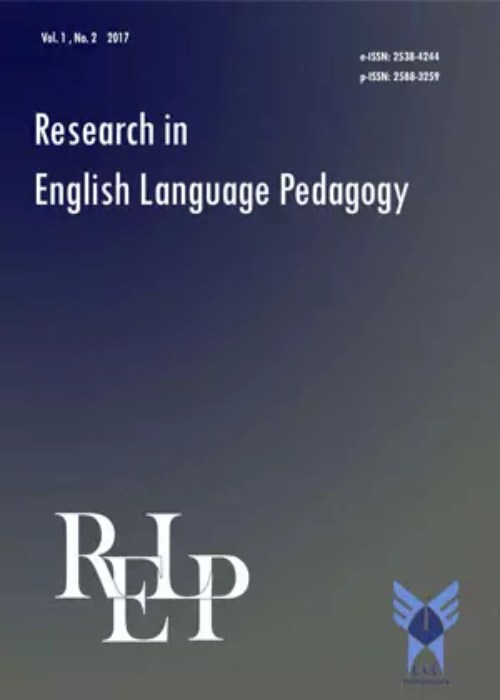فهرست مطالب

Research in English Language Pedagogy
Volume:9 Issue: 1, Winter-Spring 2021
- تاریخ انتشار: 1399/11/12
- تعداد عناوین: 9
-
Pages 1-23The present research scrutinized the use of politeness strategies in gratitude expressions of English and Persian users of Instagram. For that purpose, 200 gratitude posts were collected, 100 of which belonged to English users and the other 100 posts were composed by Persian users of Instagram. This investigation alsoevaluated gender roles in the production of gratitude utterances. Seeking to discover the politeness patterns for each language on Instagram, the data were analyzed based on Brown and Levinson's (1987) taxonomy of positive and negative politeness strategies. The findings suggested some differences in the use of the second (Exaggeration), the forth (Use of in-group identity markers), and seventh (Presuppose/raise/assert common ground) positive politeness strategies, and the seventh negative politeness strategy (Impersonalizing the speaker and the hearer) between the English and Persian users which might be due to some existent cultural transfer, and regarding the gender investigation, no significant differences were observed between females and males of each language. This is indicative of the idea that Instagram has turned into a distinguished genre of language possessing certain features such as gender-free, direct, and intimate language.Keywords: Computer-mediated communication, gender, Gratitude, Instagram, Politeness strategies
-
Pages 24-50
In order to expand the literature on the concept of teacher success and buttress the previous findings in this regard, this study attempted to explore characteristics of successful EFL teachers from EFL learners' and teachers' perspectives. Thirty Iranian undergraduate EFL learners and 30 EFL teachers were interviewed and also responded to the Successful EFL Teachers Questionnaire. The content analysis of the interview data showed a number of themes emphasized mutually by the two groups; among them being knowledgeable followed by being competent at teaching and conveying knowledge were the most frequent themes. Further interview findings uncovered some themes stated exclusively by learners and some others exclusively by teachers. The descriptive statistics also revealed that the 12 subscales of the questionnaire were ranked mostly in the same order of importance by both groups, and the Mann-Whitney U test outcomes evinced significant differences regarding the perspectives of the learners and teachers only for four subscales of the questionnaire. All in all, based on the results, it was concluded that, compared to the teachers, the learners held a more restricted conceptualization of the qualities of successful EFL teachers. Accordingly, pedagogical implications were suggested in the English language teaching and learning context of Iran.
Keywords: EFL learner, EFL teacher, Successful English teacher, Triangulation of perspectives -
Pages 51-69Linking adverbials as cohesive features tie the ideas to form dynamic and satisfactory text. This study intended to investigate the use of linking adverbials in two spoken genres; student presentations (Class other than a seminar in which one or more students speak in front of the class or lead the discussion) and discussion sections (Additional section of a lecture class designed for maximum student participation; maybe also called recitation). To this end, the study was based on the data collected from a corpus including 11 student presentations and nine discussion sections. The data were taken from MICASE (the Michigan Corpus of Academic Spoken English) corpus and then analyzed based on Liu’s (2008) taxonomy of linking adverbials. The results indicated that in both genres additive and sequential classes of linking adverbials have received similar attention while the two genres were different in the proportion dedicated to the realizations of additive and causal/resultive classes of linking adverbials. The results pointed to differences concerning the use of subclasses adversative linking adverbials in both genres. The results of this study could have a contribution in teaching these important cohesive features in ESL classes aiming to improve students in relation to these two genres.Keywords: Discussion Sections, Linking Adverbials, Spoken Genres, Student Presentations
-
Pages 70-89This study addressed the impact of teaching critical thinking (CT) principles through argument mapping (AM) techniques on the CT and reading abilities of a number of Iranian male and female EFL learners who studied English at a language institute in Isfahan province. For this purpose, 30 male and 30 female intermediate EFL learners were chosen on the basis of their performance on the Oxford Quick Placement Test (OQPT); further, the reading section of an IELTS practice test was applied. For the collection of the required data, California Critical Thinking Skills Test (CCTST), which had been validated in Persian, was conducted twice, once before and once after the treatment. The study employed a quantitative pretest-treatment-posttest design in which AM techniques including information organization, structure reasoning, evidence consideration, assumption identification, evaluation of arguments, and communication of conclusions were introduced to the participants in 6 steps. Then, the CCTST and IELTS reading sections were administered again as the posttests. The statistical analysis of the obtained results using the paired-samples t test, based on the comparison of CT and reading ability according to the scores obtained from the pretest and posttest taken by the male and female learners, revealed the improvement in the five subcomponents belonging CT and reading ability from pretest to posttest. The present study provides insights useful for EFL teachers, learners and materials developers.Keywords: Argument mapping, critical thinking, gender, Iranian EFL learners, reading comprehension
-
The Iranian Intermediate EFL Learners` Attitudes towards Using Flipped Teaching via Google ClassroomPages 90-112Flipped teaching is the process of moving lecture content from face-to-face class time to before class. The potential values of flipped teaching in which learners are actively engaged in the learning process have been emphasized during the past years; however, there is still little research evidence about the attitudes of the learners towards flipped teaching and the use of technology. The present investigation aimed to explore Iranian EFL learners' attitudes towards flipped teaching. To this end, 40 female intermediate EFL learners with the age range of 19 to 29 from the training department of the National Iranian Oil Company (NIOC) in Khuzestan, Iran, based on the Oxford Quick Placement Test (OQPT) were selected through convenience sampling and assigned into two groups with the same instructional strategies since having 40 students in a single class was not possible. An attitude questionnaire was examined in terms of frequencies and percentages. The results of frequency analyses indicated that EFL learners in the study had a positive attitude towards flipped teaching and agreed that it was helpful to them in many ways. The findings can be of significance for EFL learners, instructors, and syllabus designers.Keywords: attitudes, Autonomous Learning, Classroom Engagement, Flipped Teaching, Google Classroom
-
Pages 113-134Task-based language teaching (TBLT) with its strong theoretical bases and emphasis on meaningful and interactive use of language has received substantial attention in the context of foreign language teaching. The present study investigated the extent to which TBLT was incorporated into the textbooks and the extent to which teachers were aware of its concept in the bilingual education setting in Mazandaran province, Iran. A descriptive qualitative approach, using content analysis of the textbook based on a general task framework (Ellis, 2003) and a survey through a questionnaire, was employed to determine the implementation of tasks. Findings related to the textbook analysis indicated that the number of tasks in the textbook was relatively limited for real communication. Regarding the teachers’ (n=28) perceptions of TBLT, the results of the one-sample t-test analysis revealed that the participating teachers agreed with the idea of using tasks in teaching English language. Based on the findings, it is recommended that TBLT materials should be included in the bilingual textbooks in order to enhance learners’ collaboration and interactional skills.Keywords: Bilingual education, tasks, TBLT, Teacher’s perspective, Textbook evaluation
-
Pages 135-158This study investigated the content of peer feedback dynamics using patterns of pair interaction among Iranian EFL learners in English writing class, making use of Audio Stimulated Recall (ASR) interview and the compositions. This qualitative case study was conducted comprising twelve EFL learners at Poldokhtar University. Three kinds of data, including semi-structured interviews, writing assignments, and the artifacts of peer feedback dynamic using patterns of pair interaction, were analyzed by software NVivo 8.0. The findings revealed that the quality of writing was improved by peer feedback dynamics using patterns of pair interaction; the content of peer feedback dynamics became more detailed and various, and the content of peer feedback dynamics focuses on the six aspects including mechanics, syntax, error correction, pragmatic functions, word choice, and style.Specifically, students perceived the contents of the writing, reinforced their critical thinking ability, and enhanced their social interaction skills. Hence, peer feedback should be implemented in L2 writing. Some implications of the study were discussed.Keywords: Content of Peer Feedback, Iranian EFL learners, Patterns of Pair Interaction, Peer Feedback Dynamics, writing skill
-
Pages 159-181One of the most important factors influencing the participation of English language learners is the willingness to communicate and trying to reduce reticence. The purpose of this study was to predict daily class participation based on reticence and willingness to communicate. The sample for the current research was selected from the students of the English language department, College of Basic Education, the University of Halabja in Kurdistan Region of Iraq, and students of the English Language Department at the University of Kurdistan, Sanandaj in Iran and the sample number was 200 people. The data of the present study came from two questionnaires consisted of two scales measuring Reticence scale, and Willingness to Communicate (WTC) scale to measure students’ predisposition towards approaching or avoiding communication. According to the results of regression analysis, reticence can be a significant predictor of students' participation in daily classroom activities. Furthermore, the results indicated that the relationship between willingness to communicate and participation in class activities in both groups of boys and girls was statistically positive and significant. The results of regression analysis also revealed that willingness to communicate can significantly and positively predict students' participation in daily classroom activities.Keywords: Class Participation, EFL learners, Reticence, Willingness to communicate
-
Pages 182-199The quantitative-qualitative content analysis study reported in this paper investigated if there was any significant difference between the listening and reading sections of IELTS tests with regard to the representation of learning objectives of Revised Bloom’s taxonomy. For this purpose, 16 Academic IELTS listening and reading tests from Cambridge IELTS Academic: Authentic Practice Tests (IELTS 12, 13, 14, and 15) were selected as the material of the study. The content of the tests was codified based on a coding scheme developed by the researchers. The reliability of the coding was evaluated through the inter-coder and intra-coder reliability analyses. The frequency, Chi-square and Cramer's V tests were employed to analyze the data.The results indicated that IELTS listening and reading tests mostly included Understanding Factual and Conceptual Knowledge, respectively. Furthermore, the results showed that there was a substantial difference between IELTS listening and reading tests with regard to the inclusion of learning objectives. It was concluded that the listening and reading tests of IELTS assessed different learning objectives. The implications of the study suggest that IELTS candidates, teachers, and researchers should take the different learning objectives represented in IELTS listening and reading tests into consideration.Keywords: IELTS Learning objective, listening, Reading, Revised Bloom’s Taxonomy, Learning objective


